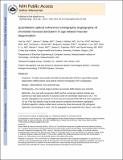| dc.contributor.author | Jia, Yali | |
| dc.contributor.author | Bailey, Steven T. | |
| dc.contributor.author | Wilson, David J. | |
| dc.contributor.author | Tan, Ou | |
| dc.contributor.author | Klein, Michael L. | |
| dc.contributor.author | Flaxel, Christina J. | |
| dc.contributor.author | Liu, Jonathan Jaoshin | |
| dc.contributor.author | Kraus, Martin F. | |
| dc.contributor.author | Fujimoto, James G. | |
| dc.contributor.author | Huang, David | |
| dc.contributor.author | Potsaid, Benjamin M. | |
| dc.contributor.author | Lu, Chen David | |
| dc.date.accessioned | 2015-12-14T01:29:56Z | |
| dc.date.available | 2015-12-14T01:29:56Z | |
| dc.date.issued | 2014-03 | |
| dc.date.submitted | 2014-01 | |
| dc.identifier.issn | 01616420 | |
| dc.identifier.uri | http://hdl.handle.net/1721.1/100223 | |
| dc.description.abstract | Purpose
To detect and quantify choroidal neovascularization (CNV) in patients with age-related macular degeneration (AMD) using optical coherence tomography (OCT) angiography.
Design
Observational, cross-sectional study.
Participants
A total of 5 normal subjects and 5 subjects with neovascular AMD were included.
Methods
A total of 5 eyes with neovascular AMD and 5 normal age-matched controls were scanned by a high-speed (100 000 A-scans/seconds) 1050-nm wavelength swept-source OCT. The macular angiography scan covered a 3×3-mm area and comprised 200×200×8 A-scans acquired in 3.5 seconds. Flow was detected using the split-spectrum amplitude-decorrelation angiography (SSADA) algorithm. Motion artifacts were removed by 3-dimensional (3D) orthogonal registration and merging of 4 scans. The 3D angiography was segmented into 3 layers: inner retina (to show retinal vasculature), outer retina (to identify CNV), and choroid. En face maximum projection was used to obtain 2-dimensional angiograms from the 3 layers. The CNV area and flow index were computed from the en face OCT angiogram of the outer retinal layer. Flow (decorrelation) and structural data were combined in composite color angiograms for both en face and cross-sectional views.
Main Outcome Measures
The CNV angiogram, CNV area, and CNV flow index.
Results
En face OCT angiograms of CNV showed sizes and locations that were confirmed by fluorescein angiography (FA). Optical coherence tomography angiography provided more distinct vascular network patterns that were less obscured by subretinal hemorrhage. The en face angiograms also showed areas of reduced choroidal flow adjacent to the CNV in all cases and significantly reduced retinal flow in 1 case. Cross-sectional angiograms were used to visualize CNV location relative to the retinal pigment epithelium and Bruch's layer and classify type I and type II CNV. A feeder vessel could be identified in 1 case. Higher flow indexes were associated with larger CNV and type II CNV.
Conclusions
Optical coherence tomography angiography provides depth-resolved information and detailed images of CNV in neovascular AMD. Quantitative information regarding CNV flow and area can be obtained. Further studies are needed to assess the role of quantitative OCT angiography in the evaluation and treatment of neovascular AMD. | en_US |
| dc.description.sponsorship | National Institutes of Health (U.S.) (Grant 1R01 EY023285-01) | en_US |
| dc.description.sponsorship | National Institutes of Health (U.S.) (Grant R01 EY013516) | en_US |
| dc.description.sponsorship | Rosenbaum's P30EY010572 | en_US |
| dc.description.sponsorship | National Institutes of Health (U.S.) (Clinical and Translational Science Award Grant UL1TR000128) | en_US |
| dc.description.sponsorship | Research to Prevent Blindness, Inc. (United States) (Grant R01-EY11289-26) | en_US |
| dc.description.sponsorship | United States. Air Force Office of Scientific Research (FA9550-10-1-0551) | en_US |
| dc.description.sponsorship | German Research Foundation (DFG-HO-1791/11-1) | en_US |
| dc.description.sponsorship | German Research Foundation (DFG-GSC80-SAOT) | en_US |
| dc.language.iso | en_US | |
| dc.publisher | Elsevier | en_US |
| dc.relation.isversionof | http://dx.doi.org/10.1016/j.ophtha.2014.01.034 | en_US |
| dc.rights | Creative Commons Attribution | en_US |
| dc.rights.uri | http://creativecommons.org/licenses/by-nc-nd/4.0/ | en_US |
| dc.source | PMC | en_US |
| dc.title | Quantitative Optical Coherence Tomography Angiography of Choroidal Neovascularization in Age-Related Macular Degeneration | en_US |
| dc.type | Article | en_US |
| dc.identifier.citation | Jia, Yali, Steven T. Bailey, David J. Wilson, Ou Tan, Michael L. Klein, Christina J. Flaxel, Benjamin Potsaid, et al. “Quantitative Optical Coherence Tomography Angiography of Choroidal Neovascularization in Age-Related Macular Degeneration.” Ophthalmology 121, no. 7 (July 2014): 1435–1444. | en_US |
| dc.contributor.department | Massachusetts Institute of Technology. Department of Electrical Engineering and Computer Science | en_US |
| dc.contributor.department | Massachusetts Institute of Technology. Research Laboratory of Electronics | en_US |
| dc.contributor.mitauthor | Potsaid, Benjamin M. | en_US |
| dc.contributor.mitauthor | Liu, Jonathan Jaoshin | en_US |
| dc.contributor.mitauthor | Lu, Chen David | en_US |
| dc.contributor.mitauthor | Kraus, Martin F. | en_US |
| dc.contributor.mitauthor | Fujimoto, James G. | en_US |
| dc.relation.journal | Ophthalmology | en_US |
| dc.eprint.version | Author's final manuscript | en_US |
| dc.type.uri | http://purl.org/eprint/type/JournalArticle | en_US |
| eprint.status | http://purl.org/eprint/status/PeerReviewed | en_US |
| dspace.orderedauthors | Jia, Yali; Bailey, Steven T.; Wilson, David J.; Tan, Ou; Klein, Michael L.; Flaxel, Christina J.; Potsaid, Benjamin; Liu, Jonathan J.; Lu, Chen D.; Kraus, Martin F.; Fujimoto, James G.; Huang, David | en_US |
| dc.identifier.orcid | https://orcid.org/0000-0001-6235-0143 | |
| dc.identifier.orcid | https://orcid.org/0000-0002-0828-4357 | |
| dspace.mitauthor.error | true | |
| mit.license | PUBLISHER_CC | en_US |
| mit.metadata.status | Complete | |
